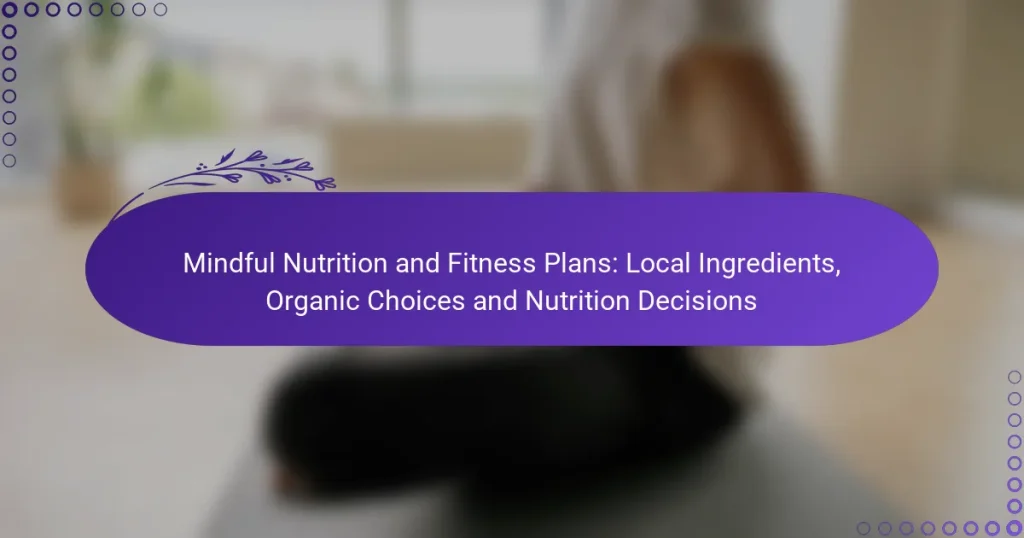Mindful nutrition and fitness plans emphasize the importance of local ingredients and organic choices, which not only enhance flavor but also boost nutrient density and sustainability. By selecting foods from nearby farms, individuals can support their local economy while making healthier dietary decisions. Additionally, prioritizing organic options helps optimize energy levels and recovery, ensuring a holistic approach to wellness.

How can local ingredients enhance mindful nutrition?
Local ingredients can significantly enhance mindful nutrition by providing fresher options that are often more nutrient-dense and environmentally sustainable. By choosing foods sourced from nearby farms, individuals can support their local economy while making healthier dietary choices.
Seasonal produce benefits
Seasonal produce is typically harvested at its peak, offering superior flavor and nutritional value. Eating in sync with the seasons can lead to a more varied diet, as different fruits and vegetables become available throughout the year.
Additionally, seasonal foods are often less expensive due to lower transportation costs and higher local supply. This can make it easier to incorporate a wider range of nutrients into your meals without breaking the bank.
Community-supported agriculture
Community-supported agriculture (CSA) programs allow consumers to buy shares of a farm’s harvest, providing a direct connection to local food producers. This model supports farmers financially and encourages sustainable farming practices.
Participating in a CSA can introduce you to new ingredients and encourage creativity in meal planning. It often results in receiving a variety of seasonal produce, which can enhance your cooking and eating experience.
Flavor and freshness advantages
Local ingredients are generally fresher than those that have traveled long distances, leading to better flavor and texture. Fresh produce retains more nutrients, making it a healthier choice for meals.
Moreover, local foods can often be harvested at optimal ripeness, enhancing their taste. This can transform simple dishes into flavorful experiences, making mindful eating more enjoyable and satisfying.

What are the best organic choices for fitness plans?
The best organic choices for fitness plans focus on nutrient-dense foods that support energy levels and muscle recovery. Incorporating organic ingredients can enhance overall health and performance while minimizing exposure to harmful chemicals.
Organic protein sources
Organic protein sources are essential for muscle repair and growth. Options include organic chicken, grass-fed beef, and plant-based proteins like lentils, chickpeas, and quinoa. These sources not only provide high-quality protein but also come with fewer additives and pesticides.
When selecting organic proteins, look for certifications such as USDA Organic to ensure quality. Aim for a variety of protein sources to cover all essential amino acids, especially if following a plant-based diet.
Whole grains and their benefits
Whole grains are a vital part of a balanced fitness plan, offering sustained energy and essential nutrients. Organic options like brown rice, quinoa, and whole wheat bread contain more fiber and nutrients compared to refined grains.
Incorporating whole grains can improve digestion and help maintain stable blood sugar levels. Aim for at least three servings of whole grains daily to support your fitness goals.
Organic fruits and vegetables
Organic fruits and vegetables are rich in vitamins, minerals, and antioxidants, making them crucial for recovery and overall health. Seasonal organic produce, such as berries, leafy greens, and root vegetables, can provide a variety of nutrients while being free from harmful pesticides.
To maximize benefits, aim to fill half your plate with organic fruits and vegetables at each meal. This not only enhances nutrient intake but also supports local farmers and sustainable practices.

How to make informed nutrition decisions?
Making informed nutrition decisions involves understanding food choices, reading labels, and recognizing the nutritional value of ingredients. By focusing on local and organic options, individuals can enhance their diets while supporting sustainable practices.
Understanding food labels
Food labels provide essential information about the contents of packaged products, including ingredients, serving sizes, and nutritional values. Familiarize yourself with key terms such as “organic,” “non-GMO,” and “gluten-free” to make healthier choices.
Pay attention to the order of ingredients listed; those appearing first are present in the highest amounts. Look for products with fewer ingredients, as they are often less processed and more nutritious.
Identifying nutrient-dense foods
Nutrient-dense foods are those that provide a high amount of vitamins and minerals relative to their calorie content. Examples include leafy greens, berries, nuts, and whole grains. Incorporating these foods into your diet can improve overall health without excessive calorie intake.
To identify nutrient-dense options, consider foods that are rich in fiber, protein, healthy fats, and essential vitamins. Aim for a colorful plate, as a variety of colors often indicates a range of nutrients.
Balancing macronutrients
Balancing macronutrients—carbohydrates, proteins, and fats—is crucial for maintaining energy levels and supporting bodily functions. A common guideline is to aim for a distribution of approximately 45-65% carbohydrates, 10-35% protein, and 20-35% fats in your daily caloric intake.
Adjust these ratios based on personal goals, such as weight loss or muscle gain. For instance, those looking to build muscle may increase protein intake while reducing carbohydrates. Always consider whole food sources for each macronutrient to maximize nutritional benefits.

What are effective mindful fitness strategies?
Effective mindful fitness strategies focus on integrating awareness into physical activities, enhancing both mental and physical well-being. These strategies encourage individuals to pay attention to their bodies, thoughts, and feelings during workouts, leading to a more fulfilling fitness experience.
Incorporating mindfulness into workouts
Incorporating mindfulness into workouts involves being present and fully engaged in the activity. This can be achieved by focusing on breath, body movements, and sensations, which helps to reduce distractions and improve performance. Techniques such as setting intentions before a workout or practicing gratitude afterward can enhance this experience.
To practice mindful workouts, consider activities like walking, running, or cycling while paying close attention to your surroundings and bodily sensations. Aim for sessions where you can maintain a steady pace and focus on your breathing, which can lead to improved mental clarity and reduced stress.
Benefits of yoga and meditation
Yoga and meditation are powerful tools for enhancing mindfulness in fitness. They promote relaxation, flexibility, and strength while encouraging a deeper connection between mind and body. Regular practice can lead to reduced anxiety, improved focus, and better emotional regulation.
Incorporating yoga into your routine can be as simple as attending a local class or following online sessions. Aim for at least one to two sessions per week to experience significant benefits. Meditation can be practiced daily, even in short sessions of five to ten minutes, to help center your thoughts and enhance overall well-being.
Local fitness classes and communities
Engaging with local fitness classes and communities can enhance your mindful fitness journey. Many cities offer classes that focus on mindfulness, such as yoga, tai chi, or Pilates, which foster a supportive environment for personal growth. Joining these classes can also provide motivation and accountability.
To find local options, check community centers, gyms, or online platforms that list fitness events. Participating in group activities not only improves your fitness but also builds connections with like-minded individuals, creating a sense of belonging and shared purpose in your mindful fitness journey.

How to choose a nutrition plan that fits your lifestyle?
Selecting a nutrition plan that aligns with your lifestyle involves understanding your dietary needs, preferences, and daily routines. A well-suited plan should promote health while being practical and enjoyable to follow.
Assessing dietary preferences
Begin by evaluating your personal food preferences, including any dietary restrictions or allergies. Consider whether you prefer vegetarian, vegan, gluten-free, or other specific diets, as these choices will significantly influence your nutrition plan.
Additionally, think about your cooking habits and how much time you can dedicate to meal preparation. A plan that incorporates local ingredients and fits your culinary skills will be easier to maintain.
Consulting with nutritionists
Engaging with a qualified nutritionist can provide personalized insights tailored to your unique needs. They can help you navigate the complexities of nutrition, ensuring that your plan includes all essential nutrients while accommodating your preferences.
When selecting a nutritionist, look for someone with relevant credentials and experience in your specific dietary interests. This professional guidance can help you avoid common pitfalls and make informed choices.
Setting realistic goals
Establish achievable goals that align with your lifestyle and nutritional needs. Instead of aiming for drastic changes, focus on gradual improvements, such as incorporating more fruits and vegetables into your meals or reducing processed foods.
Track your progress and adjust your goals as necessary. Setting small, measurable targets can help maintain motivation and lead to sustainable changes over time. Remember, consistency is key to long-term success in any nutrition plan.


